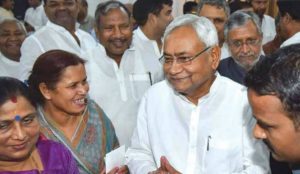 With state assembly poll due sometime in the last quarter of 2020, preparations for hustings are in the offing with all major and small political parties preparing to be engaged in flurry of hectic political activity to woo the Bihar electorate. Present dispensation headed by Nitish Kumar as chief minister is a coalition of Janata Dal (United) or JD(U) and the BJP as major coalition partners along with some smaller partners. Nitish Kumar has been at the helm since 2005 and is aspiring for the fourth term as chief minister.
With state assembly poll due sometime in the last quarter of 2020, preparations for hustings are in the offing with all major and small political parties preparing to be engaged in flurry of hectic political activity to woo the Bihar electorate. Present dispensation headed by Nitish Kumar as chief minister is a coalition of Janata Dal (United) or JD(U) and the BJP as major coalition partners along with some smaller partners. Nitish Kumar has been at the helm since 2005 and is aspiring for the fourth term as chief minister.
Prolonged spell of 15-year rule is a sufficient period to catapult the state of Bihar to growth trajectory by pulling it out of the so-called BIMARU status to a vibrant state with buoying economy, rural resurgence, and upscaling the development indicators on par with ‘developedstates’ of the national mainstream. However, the recently released report by NITI Aayog on SDG India Index 2019, which evaluates progress of states and Union Territories on social, economic and environmental scales, has adjudged Bihar as the worst performer on the SDGs (Sustainable Development Goals). These aspects constitute the subject of public probity.
Law & order
Media reports spanning the period from the JD(U)-BJP coalition assuming the power in Patna in mid-2017 onward depict a dismal scenario of the law and order situation and currently it is said to be at a very low level in the state. The reported incidents of crime have assumed alarming position entailing numerous instances of crimes against women, abduction, extortion and murder.
In the wake of disagreement among the media experts over the real cause of the deteriorating law and order situation, many experts attribute this as a fall out of absolute liquor-ban in the state, which was actually designed to make sale, consumption of liquor an offence attracting stringent punishment; nevertheless, has also resulted in the commencement of a parallel economy for liquor. Some critics opine that proliferation of illegal liquor business can’t be possible without the complicity of people in power.
What seems to have happened is that the pool of people who either engage in these crimes for their survival or out of their arrogance has become very large. While some of those who lost their livelihood because of the liquor ban seem to be engaged in petty crimes for their survival, those with the “connections” are engaged in bigger crimes as they hardly fear the authorities.
According to media reports citing findings of a recent survey conducted by the Centre for the Study of Developing Societies (CSDS) in association with Common Cause, there are two reasons for the spurt in crimes – first is attributable to inadequate police personnel, poor quality of training and outdated arms and weapons; and secondly, the connivance of the police with the people in power, and those engaged in such crimes.
Social dimensions
Education and health are two major criteria for mapping social progress. Bihar’s rank is at 36 in SDG-4, the lowest in the country in the 2019 SDGs Index. Bihar ranks as the second lowest in the School Education Quality Index report released by NITI Aayog in September 2019. Scoring of Bihar in this report in the realms of educational infrastructure and facilities, access to schools, learning outcomes and equity is also dismal and about 40 per cent of children are still out of school in Bihar.
Bihar’s performance in health sector is also dismal. According to NITI Aayog report on Healthy States Progressive India Report released on June 25, 2019, Bihar recorded the highest decline (-6.35) in the overall health score index in 2017-2018 as compared to 2015-2016. The state’s total fertility rate — the average number of children born to a woman — increased from 3.2 in 2015-16 to 3.3 in 2017-18.
The prevalence of low birth weight increased from 7.2 per cent in 2015-16 to 9.2 per cent in 2017-18. Its sex ratio at birth declined from 916 females per 1,000 males in 2015-16 to 908 in 2017-18, and its tuberculosis treatment success rate was 71.9 per cent in 2017-18 — down from 89.7 per cent in 2015-16. Besides, in Bihar, there is not a single district or sub district hospital with a quality accreditation certificate in 2017-18, a decline of 27.16 percentage points since 2015-16.
Even with regard to gender equity, the progress in Bihar is not up-to-the mark. Overall literacy in Bihar is more male-centric. The Do Kadam Barabari Ki Ore (Two Steps Towards Equality) programme that was launched in 2012 with the avowed objective of envisaging gender equity and curbing violence against women and girls has not yielded satisfactory outcomes despite many interventions.
Various research studies conducted in this regard have noted the lack of leadership skills of those delivering the intervention and the gap between expected responsibilities and activities of government platforms and reality.
Economic Dimensions
Bihar is the fifth poorest state in India. Bihar’s GDP growth rate in 2018-2019 stood at 10.53 as compared to 11.3 per cent in 2017-2018. With GDP per capita at 43,822 (US$610) in 2018–2019, Bihar’s rank is 33 in terms of GDP per capita. Bihar saw a massive drop in unemployment from 10.68 per cent (2016) to 2.48 per cent (2017) and subsequently, it has recorded a continuous rise since then to 11.82 per cent in 2019.
Even on the delivery of centrally-sponsored schemes, Bihar’s performance in recent years has been depressing as compared to other states. Under the Mahatma Gandhi National Rural Employment Guarantee Act (MGNREA), Bihar delivered only 108.4 million person days out of a target of 140 million, completed only a third of its target of rural roads, resulting in 2,095 habitations still being unconnected, built just around 388,000 rural houses out of a target of 1.17 million houses and completed skilling of only 33,636 people out of 148,500 persons it aimed to skill by March 2019. Besides, the state completed only 33 per cent of projects under SAGY during 2018-2019.
Over the past five years, Nitish government is said to have spent close to 500 crore on advertisements and such a whopping amount being spent on advertisements without achieving much in a poverty-ridden state like Bihar is not a minor issue. Undoubtedly, Nitish Kumar seeks to pull Bihar out of poverty by demanding special status for the state and asks for a special package; nonetheless on the other hand, he spends whopping amount of taxpayers’ money to build his own image through advertisements and that literally goes against his so-called image of ‘Sushasan babu.’.
Way Ahead
Deteriorating law and order situation along with worst performance on the SDG indicators and miserable performance on economic front make it explicitly discernible that development in Bihar in recent years has not resulted in improvement in quality of life.
As one expert has opined, “The propaganda of development being hyped by state government here is not translating into improvement in quality of life, generation of employment, quality of education is not improving, as schools and colleges are faced with shortage of teachers. Similarly, there has been no improvement in health sector and hospitals lack required number of doctors as well as infrastructure and many development surveys reflecting the actual development in the state demonstrate lack of quality of life in Bihar.”
Bihar is not likely to come out of its present terminal crisis unless the present dispensation puts its heart into the job. The task is much too gigantic to be handled by the present dispensation, given its proven ineptness. In the meanwhile, political scenario in the state is taking interesting turn, especially in the wake of declining influence of the BJP in the aftermath of recently-held assembly polls in Haryana, Chhattisgarh and Maharashtra and the JD (U) is looking for a larger share in the electoral pie in the forthcoming assembly polls in the state.
Recent months have seen poster wars between the JD (U) and the RJD. In response to JD (U)’s slogan of Kyon karen vichaar, theeke to hain Nitish Kumar (meaning, Where’s the need to think (about political alternatives) when Nitish Kumar is doing just fine.”), RJD came out with slogan Kyon na karen vichaar, Bihar hai bimaar (why not think for a change when Bihar is sick). The RJD chief Lalu Prasad, presently lodged in jail, tweeted “Do Hazar Bees, Hatao Nitish’ (Oust Nitish from power in 2020).”
Some analysts are sceptical about Nitish Kumar’s return to power in the light of his poor performance on all fronts despite the fact the JD(U) will fight in alliance with the BJP. Like JD (U), BJP also has little to boast of about its achievements in the state and as recent assembly elections in Jharkhand have shown that assembly election is different from Lok Sabha polls where local issues have come to rule the roost.
Besides, Nitish Kumar’s brazen desire, as one analyst has opined, “to remain in power by willingly compromising friendships and principles, along with completely confounded politics and direction, means Nitish Kumar is now a pale shadow of his old self. He is no longer the great face of development he once tried to project. There is nothing that defines Kumar’s politics or persona today, except his unabashed opportunism and U-turns.”
letters@tehelka.com












